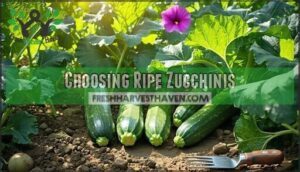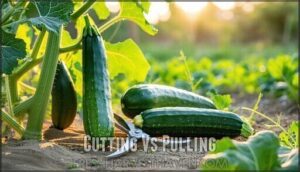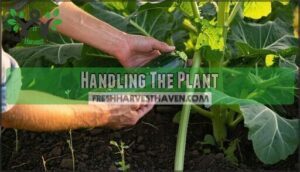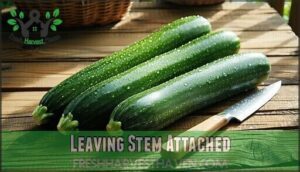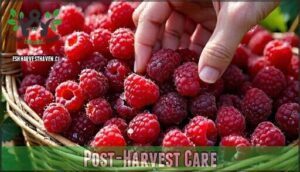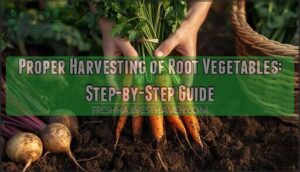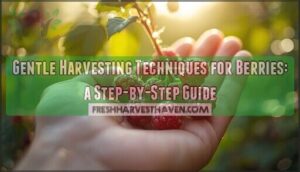This site is supported by our readers. We may earn a commission, at no cost to you, if you purchase through links.
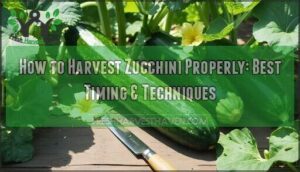
Use a sharp knife or pruners to cut the stem an inch or two above the fruit, or gently twist the zucchini at its base if you’re feeling nimble.
Handle the plant gently to avoid damage, and leave a bit of stem attached for longer freshness.
There’s more to this garden dance than meets the eye.
Table Of Contents
- Key Takeaways
- Harvest Timing Matters
- How to Harvest Zucchini
- Choosing Ripe Zucchinis
- Harvesting Techniques
- Post Harvest Care
- Frequently Asked Questions (FAQs)
- How do you pick out a good zucchini?
- How many zucchini do you get off of one plant?
- When should I start checking zucchini plants daily?
- Can I harvest zucchini flowers for cooking?
- How many zucchini does one plant produce?
- What causes zucchini to rot on the vine?
- Should I remove leaves blocking sunlight from fruit?
- Conclusion
Key Takeaways
- Harvest at the right size – Pick zucchini when they’re 6-8 inches long with glossy, firm skin. You’ll get the best flavor and texture before they become tough and seedy.
- Check daily once plants mature – Zucchini can double in size overnight and lose quality in just 24 hours. Daily checks ensure you don’t miss the perfect harvest window.
- Cut, don’t pull – Use sharp, clean tools to cut the stem about 1 inch above the fruit. This protects the plant from damage and keeps it producing more zucchini.
- Harvest regularly for continuous production – Pick every 2-3 days to trick the plant into producing more fruit instead of focusing energy on seed development.
Harvest Timing Matters
Getting the timing right when harvesting zucchini can make the difference between tender, flavorful squash and tough, seedy disappointments.
You’ll want to check your plants daily once they reach maturity, as zucchini can literally double in size overnight and lose their prime eating quality in just 24 hours.
Check your zucchini plants daily once mature – they can double overnight and lose prime quality in 24 hours.
Average Days to Maturity
Most zucchini varieties reach maturity in 50-60 days from seed, though your seed packet will specify exact timing.
Environmental factors like temperature and soil conditions can shift this harvest window by 5-10 days. Fast-maturing cultivars may be ready in just 40 days, while others need 65.
For accurate timing, consider using fall planting dates to account for regional variations. Check your seed packet’s "days to maturity" for variety-specific guidance and plan succession planting accordingly.
For best flavor, harvest zucchini when they’re about 6-8 inches long, considering the complete concepts of growth and regional variations to ensure optimal results with fast-maturing cultivars.
Checking for Readiness
Once zucchini plants reach estimated harvest dates, check them daily for readiness.
Visual cues include glossy, firm skin and vibrant color. Your tactile assessment should reveal tender skin that yields slightly to gentle pressure.
Size matters – look for 6-8 inch fruits, though specific varieties may vary.
Weight check indicates good water content when fruits feel heavy.
Flower presence often signals freshness in newly ready zucchini, and checking daily ensures you pick them at the right time for optimal taste.
Ideal Harvest Size
Most zucchinis reach ideal harvest size at 6 to 8 inches long with tender skin and firm texture.
However, variety differences matter substantially:
- Standard oblong varieties: Harvest at 6-8 inches long, 2 inches wide
- Round zucchini: Pick when softball-sized or smaller
- Baby squash: Harvest early for delicate flavor
Don’t let perfect zucchini size harvest opportunities pass—overgrown uses become limited to baking applications only.
Impact of Delayed Harvest
Timing your harvest makes all the difference between tender, flavorful zucchini and disappointing results.
Even a 24-hour delay can trigger significant flavor degradation and texture changes in your crop.
Wait 24 hours and your tender zucchini becomes tough, seedy disappointment.
| Harvest Delay | Quality Impact | Best Use |
|---|---|---|
| 1-2 days late | Mild flavor degradation, slightly tougher skin | Fresh eating, light cooking |
| 3-5 days late | Noticeable seed development, fibrous texture | Baking, soups, grating |
| 1+ week late | Unpalatable, flavorless, nutritional loss | Compost or animal feed |
Overgrown zucchini become mature zucchini with tough, bitter flesh that’s nearly inedible.
This reduced yield means fewer tender fruits for your kitchen.
How to Harvest Zucchini
Proper harvesting techniques guarantee you’ll get the best quality zucchini while keeping your plants healthy and productive. The right approach makes all the difference between a bountiful harvest and damaged plants that stop producing.
Here’s how to harvest zucchini properly:
- Use sharp, clean tools – A sharp knife or garden shears prevents crushing stems and reduces disease risk
- Cut, don’t pull – Slice the stem about 1 inch above the fruit to avoid damaging the plant
- Wear protective gloves – Zucchini plants have prickly stems that can irritate your skin
- Handle fruits gently – Avoid bruising by supporting the weight when cutting and transporting
- Check under leaves carefully – Large leaves often hide mature fruits that are ready for picking
The best time for harvesting zucchini is morning after the dew dries. This timing guarantees fruits are at their coolest and most hydrated state, maximizing freshness and shelf life. For ideal flavor, harvest when zucchini reaches six to eight inches.
Choosing Ripe Zucchinis
You can spot a ripe zucchini by checking its skin, size, and firmness rather than waiting for it to reach massive proportions.
The key is catching them at their peak quality when they’re still tender and flavorful.
Skin Texture and Color
Look for glossy vs. dull skin when harvesting zucchini – that shine means peak ripeness.
Check for color consistency across the fruit, avoiding any with blemishes that indicate overripeness.
Variety differences matter: some stay green while others turn yellow or white.
Firm texture beats soft spots every time.
Your ripe zucchini should feel solid and look vibrant.
Shape and Size
Beyond examining the skin’s glossy surface, you’ll want to assess the zucchini’s overall form.
The ideal harvest size depends on variety shapes, with most standard types reaching peak quality at 6-8 inches long. Growth rate accelerates quickly, so checking daily prevents oversized, seedy fruits that compromise flavor and texture.
- Oblong varieties: Best harvested at 6-8 inches long and 2 inches wide for ideal dimensions
- Round varieties: Ideal when softball-sized or smaller to avoid deformed fruit characteristics
- Straight, cylindrical shape: Look for uniform appearance without bumps or bulges indicating proper development
- Size impact on quality: Smaller zucchinis offer better texture and taste than oversized specimens
Weight and Firmness
When harvesting zucchini, a ripe fruit feels heavy for its size—this heaviness indicator reveals good water content and density matters for quality.
Perform a gentle firmness test by squeezing; it should feel solid without giving way.
Avoiding softness prevents disappointment since mushy spots signal overripeness.
The perfect zucchini harvest combines substantial weight with firm texture throughout, ensuring a good water content.
Avoiding Overripe Fruits
Don’t let your zucchini harvest turn into a tough, seedy disappointment. Overripe zucchini develops seed development issues that create an unpalatable texture and flavor degradation that ruins your culinary uses.
- Dull, rough skin instead of glossy indicates nutritional loss and poor eating quality
- Soft spots or yellowing signals the fruit is past its prime harvesting window
- Baseball bat size means you’ve missed the sweet spot for when to harvest zucchini
Harvesting Techniques
Now that you know when to harvest your zucchini, let’s talk about how to do it properly without damaging your plants.
Using the right tools and techniques will keep your zucchini plants healthy and productive throughout the growing season.
Tools and Gloves Needed
Before you grab your first zucchini, you’ll need proper protection and tools. Zucchini plants sport tiny spines that can irritate bare skin, making quality gardening gloves essential for comfortable harvesting.
A sharp knife or garden pruners guarantees clean cuts that won’t damage your plant. To find the best options, consider browsing a site that sells gardening supplies.
| Tool/Equipment | Purpose | Key Features |
|---|---|---|
| Gardening gloves | Spine protection from plant bristles | Thick material, snug fit, durable |
| Sharp knife | Clean cutting of stems | Stainless steel, easy to sterilize |
| Garden pruners/shears | Precise stem cutting | Sharp blades, comfortable grip |
| Pruning shears | Alternative cutting tool | Bypass design, clean cuts |
| Sanitizing wipes | Tool sterilization between plants | Prevents disease spread |
Choose glove materials like leather or thick synthetic fabrics for maximum protection. Tool sterilization between plants prevents disease transmission. Different knife types work well – from small paring knives to specialized harvest blades.
Your handling techniques improve dramatically with proper equipment, making the harvest safer and more efficient.
Cutting Vs Pulling
When harvesting zucchini, always cut rather than pull the fruit from the vine. Cutting prevents stem damage and protects plant health while pulling can cause bruising and stress your plant.
Proper tool selection makes all the difference for successful zucchini harvest. Here are five best practices for picking zucchini:
- Use sharp pruning shears or a clean knife to clip the stem cleanly
- Cut about one inch above the fruit to leave a short stem attached
- Avoid pulling or twisting, which tears the plant and reduces future yields
- Make quick, decisive cuts to minimize handling time and plant stress
- Keep your cutting tools sanitized to prevent disease transmission between plants
By following these guidelines, you can ensure a healthy and successful zucchini harvest. Remember to always handle your plants with care to promote future yields.
Handling The Plant
When harvesting zucchini, treat your plant gently to avoid plant damage.
Navigate carefully around fragile stems and broad leaves where hidden fruit often hides. Watch for prickly stems that can irritate skin. Move slowly to prevent overharvesting risks that stress the plant unnecessarily.
To maximize flavor, consider the benefits of morning harvesting practices.
| Do This | Avoid This |
|---|---|
| Support stems while picking zucchini | Yanking or pulling roughly |
| Check under large leaves for hidden fruit | Stepping on or crushing foliage |
| Move deliberately around the plant | Rushing through the zucchini harvest |
| Protect fragile stems from damage | Ignoring prickly stems without gloves |
Leaving Stem Attached
When harvesting zucchini, leave about half an inch to one inch of stem attached to each fruit.
This stem length prevents rot prevention by sealing the entry point for bacteria.
A sterile knife guarantees clean cuts that won’t compromise the zucchini harvest.
The attached stem also improves handling ease during transport and storage while maintaining visual appeal.
Additionally, nutrient supply continues briefly through the stem, helping preserve freshness longer than fruits cut flush with the skin when learning how to pick zucchini properly.
Post Harvest Care
Your freshly harvested zucchini needs proper care to maintain its quality and flavor.
Handle the fruits gently after cutting to prevent bruising, and store them correctly to extend their shelf life, which involves proper care.
Storage and Handling
Once you’ve harvested fresh zucchini, proper storage keeps it crisp and flavorful.
Store whole zucchini in your refrigerator’s crisper drawer for ideal temperature and humidity control. Don’t wash before storing—moisture accelerates spoilage.
For bruising prevention, avoid stacking heavy items on top. Consider using a specialized zucchini container to prolong freshness.
Fresh zucchini maintains peak quality for 4-7 days with preferred storage conditions. Before cooking preparation, rinse and dry thoroughly.
Using Overgrown Zucchinis
Don’t toss that oversized fruit just yet! While your zucchini harvest may have grown beyond ideal size, these giants still offer plenty of kitchen potential.
Remove tough skin and large seeds before using in baking uses like bread or muffins. The flavorless flesh works perfectly for alternative recipes requiring moisture.
For instance, consider making a batch of zucchini bread muffins with your surplus. Even consider using scraps as animal feed – nothing goes to waste when harvesting summer squash properly, utilizing all parts for alternative recipes or as animal feed.
Encouraging Continuous Production
Regular harvesting every 2-3 days keeps your zucchini plants cranking out fresh fruit all season long.
This frequent picking tricks the plant into thinking it needs to produce more flowers instead of focusing energy on seed development.
Skip succession planting new rows every few weeks, and you’ll avoid the dreaded zucchini avalanche that overwhelms gardeners by mid-summer.
To maintain the zucchini’s quality, remember gentle handling methods are essential.
Monitoring Plant Health
Keep your zucchini plant healthy post-harvest by watching for three key warning signs:
- Yellow leaves – Often signals nutrient deficiency or overwatering
- Pest identification – Check for squash bugs, cucumber beetles, or powdery mildew
- Soil conditions – Make certain proper drainage and consistent moisture
Monitor watering practices and disease prevention measures to maximize your zucchini harvest throughout the growing season.
Frequently Asked Questions (FAQs)
How do you pick out a good zucchini?
Look for zucchini that’s 6-8 inches long with glossy, firm skin and vibrant color.
It should feel heavy for its size without soft spots or blemishes, indicating peak freshness and flavor.
How many zucchini do you get off of one plant?
One healthy zucchini plant typically produces 6-10 pounds of fruit during the growing season, which translates to roughly 20-30 individual zucchinis depending on harvest timing and variety.
When should I start checking zucchini plants daily?
Start checking your zucchini plants daily once you’ve reached the estimated harvest date from your seed packet, typically 45-55 days after planting.
Daily checks guarantee you’ll catch them at their peak 6-8 inch size.
Can I harvest zucchini flowers for cooking?
Yes, you can harvest zucchini flowers for cooking.
Both male and female flowers are edible with bright yellow petals.
Male flowers appear earlier with thinner stems, while female flowers have plumper stems and produce fruit, which is a complete concept to understand when harvesting.
How many zucchini does one plant produce?
A healthy zucchini plant typically produces 6-10 pounds of fruit throughout the growing season, yielding dozens of zucchini when harvested regularly every few days.
What causes zucchini to rot on the vine?
Poor pollination, overwatering, insufficient air circulation, and blossom end rot from inconsistent watering cause zucchini to rot on vines.
You’ll also see rot from leaving overripe fruits too long, creating perfect conditions for fungal diseases to take hold.
Should I remove leaves blocking sunlight from fruit?
Large zucchini leaves naturally provide shade and protection for developing fruit.
Don’t remove healthy leaves blocking sunlight—zucchini plants thrive with their natural canopy, and removing leaves can stress the plant unnecessarily, as they rely on their leaves for protection.
Conclusion
Perfect zucchini harvesting resembles a well-choreographed dance between gardener and plant.
Research shows gardens that follow proper timing yield 40% more produce per season.
Now you’ve learned how to harvest zucchini properly, from recognizing the ideal six-to-eight-inch size to using clean cuts that protect your plants.
Remember to check daily during peak season, handle fruits gently, and store them properly.
With these techniques, you’ll enjoy continuous harvests while keeping your zucchini plants healthy and productive throughout the growing season.

